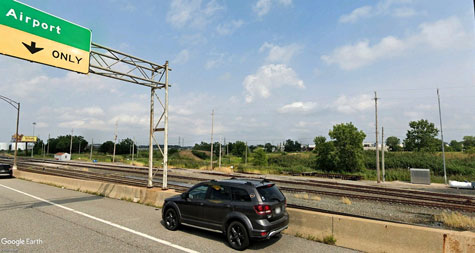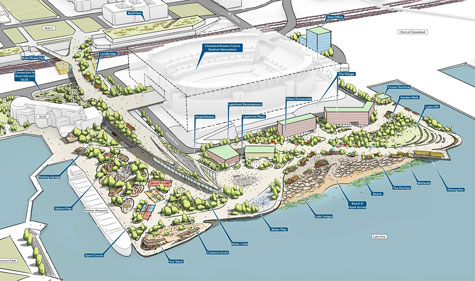Sources: Cleveland Browns Owners Reach Agreement to Purchase 176 Acres in Brook Park
by Ken Prendergast, NEOTrans | Feb. 8, 2024 | 2:30 PM

This article was published through an exclusive partnership with NEO-trans.blog.
Update: The Cleveland Browns have responded to this report with the following. "We appreciate the collaborative process with the City of Cleveland and the leadership of Mayor Bibb in analyzing the landbridge and renovating the current stadium. At the same time, as part of our comprehensive planning efforts, we are also studying other potential stadium options in Northeast Ohio at various additional sites." Read the full statement.
The owners of the Cleveland Browns football team have reportedly reached a purchase agreement to acquire a large piece of land in the Cleveland suburb of Brook Park, leading to speculation that the Browns could leave the city of Cleveland for the second time in its 78-year history.
According to three sources who spoke to the breaking news real estate blog NEOtrans (North East Ohio transformation) on the condition of anonymity, the Haslam Sports Group has a contract to buy a 176-acre parcel that's nine miles southwest of Downtown Cleveland. It is about 1,000 feet from Cleveland Hopkins International Airport, located on the other side of Ohio Route 237 and the Norfolk Southern railroad tracks.
It remains to be seen what is the purpose of the reported Brook Park purchase agreement. It may be an attempt by the Haslam Sports Group to build a football stadium in Cleveland's suburbs. It could also be an insurance policy by the Haslams in case talks with City of Cleveland officials fail to produce a deal very soon for the renovation of the city-owned Cleveland Browns Stadium on Downtown's lakefront. The Browns' lease at the stadium expires after the 2028 football season.

The sources did not say if the property is for a new stadium, but it is big enough that it certainly meets the criteria for one. That criteria is a level, 100-plus-acre site with good transportation access. This site exceeds those requirements as it is within walking distance to the airport, accessible to Route 237, Interstates 71 and 480 plus the Greater Cleveland Regional Transit Authority's Red Line rail rapid transit.
Formerly the site of two Ford Motor Co. plants, and next to a third Ford plant that remains active, the nearly 210-acre property is being redeveloped by a mostly local consortium as the Forward Innovation Center-West, 18300 Snow Rd. A 33-acre parcel was carved out for the first tenant of the business park — a roughly 370,000-square-foot Amazon distribution center that opened about one year ago.
Developing the Forward Innovation Center-West is a partnership of Weston, Inc. of Warrensville Heights, the DiGeronimo Cos. of Independence and Scannell Properties of Indianapolis. They created a joint venture called DROF BP I LLC (spells “Ford” backward and “BP” referring to Brook Park), which purchased the land in April 2021 for $31.5 million, according to county records.
In a NEOtrans interview, a real estate insider speculated last summer that the Brook Park site would be among several considered by the Browns if negotiations with the City of Cleveland failed to produce a cost-sharing deal promptly for a nearly $1 billion renovation of the 1999-built, 67,431-seat stadium.
"It is my understanding that we continue to have positive and productive talks with HSG/Browns," says City of Cleveland Press Secretary Marie Zickefoose, "That's all I am aware of."
A City of Cleveland source says that it's unlikely the Haslams would secure a purchase agreement merely to motivate Cleveland officials to move faster or to pursue a better deal for the Haslams. The reason is that city officials don't know about the Brook Park agreement. Leverage works only if the target is made aware of it.
"No one is scrambling" to respond to any purchase agreement, the source says. He assured NEOtrans that city officials want to keep the Browns in Cleveland. Losing the team again, even if to a suburb, would be an emotional issue for Cleveland residents and a loss of prestige for the city, regardless of any positive or negative fiscal impact on the city.
Interestingly, 12 of 32 NFL teams already play their home games in suburban municipalities. That number would grow to 13 if the Chicago Bears follow through in possibly moving from downtown to Arlington Heights. Several other teams play within the city limits of their metro area’s “mother city” but not downtown, such as the Tampa Bay Buccaneers, Philadelphia Eagles and Green Bay Packers.
NEOtrans sent emails seeking confirmation and comment to Cleveland Browns Senior Vice President of Communications Peter John-Baptiste, Brook Park Mayor Edward Orcutt and Weston's President of Acquisitions & Development T.J. Asher. None have responded to the e-mails to dispute or confirm the information before publication of this article. NEOtrans' tracking program shows that someone had opened each of those e-mails.
City, county and state officials have been engaged in negotiations with the Haslam Sports Group led by the husband-and-wife team of Jimmy and Dee Haslam. The clock is ticking on the team's 30-year lease with the city for use of the 25-year-old Cleveland Browns Stadium on the lakefront.
With the Browns' lease due to expire after the 2028 football season, funding procurement for a new or renovated stadium and design work would have to begin soon. But that work would need to start sooner if the Browns have to build a new stadium.
Construction of a new stadium could take about three or four years while renovations might need two off seasons — after the 2027 and 2028 seasons. Typically, it can take up to a year for a purchase agreement to close and result in a deed transfer. It is not known when the agreement was signed. And not all land contracts result in a purchase.
In July 2023 and again in September, NEOtrans reported stadium negotiations were faltering. NEOtrans shared insights from two sources, one a City of Cleveland source and the other a Browns source, who says a deal had to be done in “a matter of months, certainly less than a year” to keep the Browns in Cleveland.
"The only thing Dee and I would say for sure is we’re not leaving Northeast Ohio, that's for sure," Jimmy Haslam said in July 2023. "Our preference is for us to be on the lakefront. But we’ve got to see how things play out. It will be fluid. There will be bumps in the road and it may be different in three months than it is now.”

But Cleveland city officials are under pressure from constituents to invest more in public safety, infrastructure, housing and other neighborhood quality-of-life issues. If a football stadium is to be renovated, many residents say the city should share that cost burden with more of Northeast Ohio’s political jurisdictions. A recent Cleveland Scene article noted that only 15% of Browns game attendees reside in the city of Cleveland and 31% live in Cuyahoga County.
In November 1995, a county-wide vote was held to extend by 10 years a "sin tax" on alcohol and tobacco products to pay for stadium renovations supported by then-Browns owner Art Modell. Instead, just days before that vote, he announced he would take the Cleveland football franchise to Baltimore after the 1995 season. The sin tax extension passed with 70 percent of voters in support. Lawsuits from the city and the fans forced the Browns’ name, colors and history to remain here.
The sin tax, generating about $14 million per year, was used by the county and city to build the new Browns a new lakefront stadium that opened in 1999. That project also tapped parking tax revenues, state dollars and a funding contribution from the NFL. Those financial resources may be on the table again but another sin tax extension is more complicated.
With the sin tax due to expire, 56% of Cuyahoga County voters in 2014 extended the tax another 20 years to help the Cavs basketball and Guardians baseball teams fund their facilities’ improvements. If the Browns want to tap the sin tax again, it would have to be extended by voters before it expires in 2035. But the Haslams could provide a significant, private-sector contribution to any stadium project.
The Haslam family, including Jimmy and Dee Haslam, sold to Warren Buffett's Berkshire Hathaway an 80% stake in Pilot Travel Centers, the largest U.S. truck stop chain, for $11 billion in two separate deals, in 2017 and 2023. The sale of the remaining 20 percent stake was cleared when a lawsuit was settled last month regarding the valuation of the remaining stake which could be in the $2 billion to $3 billion range. Terms of the settlement weren't disclosed.
A new, open-air, 60,000- to 70,000-seat stadium could cost up to $2 billion to build. Stadiums with a lid cost even more — $2.5 billion for a fixed-roof venue, or at least $3.5 billion for a stadium with a retractable roof.
NFL owners are extremely competitive with each other, not only with the teams they put in their stadiums but among the stadiums themselves. The backers of each new stadium try to outdo the ones that came before in terms of design, technology, amenities for fan experiences and for attracting players.
Owners also are increasingly providing "ballpark villages" around their teams' stadiums as well as their practice facilities, offering hotels, luxury apartments, shopping, wellness centers, digital gaming and other interactive, fan-friendly sports venues.
The stadium situation does not affect the proposed expansion and development of the Browns' practice facilities in Berea, called the CrossCountry Mortgage Campus. It is less than two miles from the Forward Innovation Center-West site in Brook Park. The area for the expanded practice facilities and potential supportive mixed-use developments grew to 34 acres last fall and could grow further.
The Brook Park site's proximity to Cleveland's airport, if developed with a football stadium, could provide the Browns with an amenity that no other NFL team could match. Constructing a new long-term airport parking garage with a 1,000-foot-long enclosed walkway extending over Route 237 and the railroad could connect the city of Cleveland-owned airport with a new football stadium's facilities.
In other words, someone could walk from their airplane seat to their stadium seat without going outside. This year, the City of Cleveland is about to begin design work for Cleveland Hopkins International Airport's $3 billion Terminal Modernization Development Program that could include new roadways, walkways, parking and rental car areas, better transit access, hotels and, of course, terminal facilities.
Previously, the Forward Innovation Center-West was home to Ford Motor Co.'s 1.7-million-square-foot Ford Engine Plant No. 2 and its neighboring Cleveland Casting Plant. The casting plant was demolished in 2013 and Engine Plant No. 2 was razed in 2021. Both are just south of a remaining Ford factory, Engine Plant No. 1. Forward Innovation Center-East, another former Ford auto plant but in the southeast suburb of Walton Hills, is also being marketed by the same partnership.
In Downtown Cleveland, Mayor Justin Bibb's administration has been pursuing redevelopment of the Lake Erie waterfront with recreational facilities, housing and shops. It would be connected to the central business district and the riverfront via a pedestrian accessway called the North Coast Connector over the Shoreway highway.
The Shoreway is proposed to be downgraded from a highway into a boulevard. The connector would cross the roadway and the lakefront railroad and light-rail transit tracks. It could link up with a multimodal transportation center served by Greater Cleveland Regional Transit Authority light rail trains and buses plus Amtrak trains. Final designs for the "Shore to Core to Shore" vision are to be released early this year.
Conceptual lakefront plans released in October showed a renovated football stadium but offered little detail about it. On Feb. 1, city and county officials were in Washington, D.C., to lobby the Departments of Commerce and Transportation for hundreds of millions of federal dollars for lakefront infrastructure investments. County Executive Chris Ronayne was among those on the trip.
"The City of Cleveland requested that Cuyahoga County join them in Washington, D.C., to make a presentation on the Shore to Core to Shore Vision, which the county supports," says county Director of Communications Kelly Woodard. She says county officials are unaware of Haslam's reported Brook Park land purchase agreement.
The state of Ohio's draft capital budget also has $20 million in it for the Shore to Core to Shore plan, including the North Coast Connector. When addressing the difficulties in the stadium negotiations with the city last year, Dee Haslam says the lakefront improvements are needed with or without the football stadium — seemingly setting the stage for what appears to be happening now.
"Outside of us (the Haslam Sports Group/Browns), the lakefront in Cleveland has to be developed," she says. "You need a vibrant city. That’s a really important part of who Cleveland should be. We think the connection bridge has to happen regardless of what happens with our stadium."
Dick Clough, executive board chairman of the lakefront advocacy group Green Ribbon Coalition, says the lakefront would be better off with year-round uses like recreation, residences, hotels and shops rather than the seldom-used football stadium dominating it.
"I never liked the stadium on the lakefront," Clough says. "It ruins the scale of everything else down there. It's just a huge rectangular thing that dwarfs everything else nearby including the Rock and Roll Hall of Fame and the Great Lakes Science Center. If you're going to lose a team to the 'burbs, the Browns would be the one to lose. It's only 10 games (per year) and maybe a concert or two."
For more updates about Cleveland, sign up for our Cleveland Magazine Daily newsletter, delivered to your inbox six times a week.

Ken Prendergast, NEOTrans
Ken Prendergast is a local professional journalist who loves and cares about Cleveland, its history and its development. He has worked as a journalist for more than three decades for publications such as NEOtrans, Sun Newspapers, Ohio Passenger Rail News, Passenger Transport, and others. He also provided consulting services to transportation agencies, real estate firms, port authorities and nonprofit organizations. He runs NEOtrans Blog covers the Greater Cleveland region’s economic, development, real estate, construction and transportation news since 2011. His content is published on Cleveland Magazine as part of an exclusive sharing agreement.
Trending
-
1
-
2
-
3
-
4
-
5










